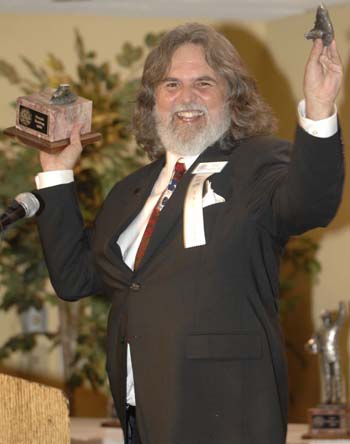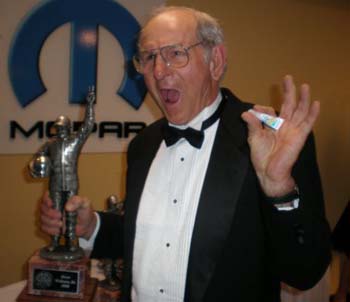CRASHING THE HALL OF FAME
Fri, 2008-03-21 13:16
Dave Wallace turned a lifetime of getting the numbers right into Hall of Fame status …

Mike Bumbeck Photo

Dave
Wallace began his drag racing career as an 11-year old ET slip
distributor before developing into one of drag racing's more prominent
journalists.
Dave Wallace turned a lifetime of getting the numbers right into Hall of Fame status …

Mike Bumbeck Photo

Dave
Wallace began his drag racing career as an 11-year old ET slip
distributor before developing into one of drag racing's more prominent
journalists.
The table holding the beautiful trophies collapsed, sending the precious awards crashing to the floor.
Wallace shook his head in disbelief. Then the emotion came. The former founding editor for Petersen’s Drag Racing magazine and past Hot Rod staffer handled the situation in the same manner he’s handled adversity in his thirty-year plus career. He laughed and later hoisted two pieces of a broken trophy in the air.
“I thought Wally Parks was in the room,” Wallace said. “Wally had to have been spinning because I was getting in there. I knew he was making his presence known.”
Wallace loves to write drag racing stories and reporting became a natural avenue to participate.
“I think the reason I got into this was because I had the pleasure to see some people do some amazing things for little or no money and I felt I needed to be there to get my share of the numbers right,” Wallace said. “I always tried to get those numbers right because of what every one went through to win out there. The numbers were very important.”
This was Wallace’s mantra. He was a stickler for the small details in a story. He used the hundredths of a mile per hour clocking, but his message went well beyond this simple example.
Being a drag racing reporter demands a lot of hard work and doesn’t pay a whole lot of money. I got $5 for my first story. I worked about eight hours to make that money, too. – Dave Wallace on making a career as a drag racing freelancer

Always
the humorist, Wallace held up the remnants of one of the trophies to
the applause and laughter of the audience. (National DRAGSTER)
For Wallace, the memories of those days in the mid-1960s working at the San Fernando Drag Strip as a cub reporter and witnessing the pre-safety days, molded his intense work ethic in drag racing. He earned his first job working under his father Dave Wallace, Sr., writing as the track reporter.
“Being a drag racing reporter demands a lot of hard work and doesn’t pay a whole lot of money,” Wallace said, pointing out his first byline appeared in Drag News back in 1964. “I got $5 for my first story. I worked about eight hours to make that money, too.”
Wallace was only 14 years old when he mailed the first submission. He later submitted articles to Hot Rod as a teenager.
“The satisfaction for me was seeing it all come together one Sunday night when my dad gave me a chance to write,” Wallace admitted. “I rode with him to the post office to drop the story off in time for the last special delivery.”
Wallace was blown away when he saw his first article distributed throughout the Los Angeles area just 48 hours later.
“I’m still impressed with the way things worked back then, even in today’s Internet age,” Wallace said.
Wallace went to Vietnam for a tour of duty and returned to resume his love of drag racing from the journalistic side in 1971. He worked at Lions Dragway until C.J. Hart left. Wallace then became the PR director for Orange County International Raceway in southern California.

Never fear -- Garlits arrived with a tube of Super Glue.
Wallace recalled his first aggressive experience in reporting.
“This was in the time when a lot of the big name racers were running for Larry Carrier at the IHRA,” Wallace explained. “Don Prudhomme wasn’t running there and I had heard a rumor why, so I called Carrier to get the story.”
According to Wallace, Carrier pointed out his objection to Prudhomme’s car running under the U.S. Army banner and the belief the car was funded by taxpayers. Carrier reportedly went on to inform Wallace he didn’t want the Army or Prudhomme there.
“I ran the quote in the paper and got in big trouble,” Wallace said. “RJ Reynolds [Winston] got mad and even Wally Parks called me.”
Evidently Wallace didn’t get the message the sanctioning bodies were aiming to keep controversy to a minimum in the first year of the Winston sponsorship. He called Prudhomme who then told him he didn’t want to race for an organization whose sponsor could provide his young daughter with a sample pack of cigarettes.
“I ran that quote too,” Wallace said, breaking into laughter. “I think I pretty much made everyone else that I left out in the first half mad at me then.”
This wouldn’t be the first or last time he drew the ire of the sanctioning bodies. In 1988, there was an infamous photo published of then IHRA President Billy Meyer sticking out his tongue.
You guessed it, Wallace snapped the infamous photo.
But, in the end, his fearless style of journalism and the demand for accuracy is what put the veteran wordsmith into the International Drag Racing Hall of Fame.
“I wasn’t smart enough to race a car, but I did find a niche I felt that I could fit in,” Wallace admitted. “I have tried to always get it right [when reporting] and when I didn’t I found out about it.
“I’m just glad one of the selectors Ted Jones [former IHRA Vice President] and Steve Gibbs [then NHRA competition director] didn’t hold the Drag News thing against me.”
Categories:




































